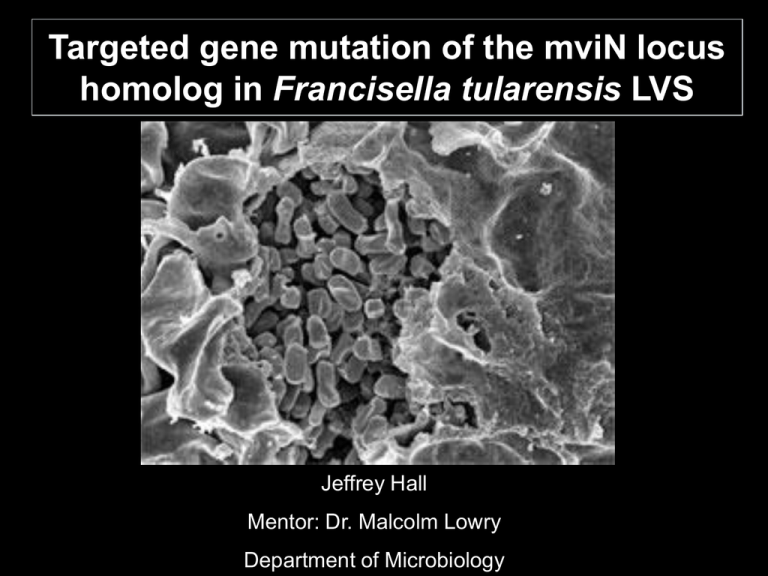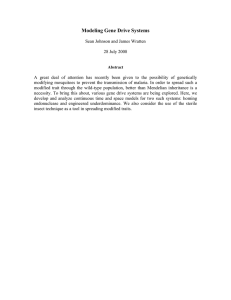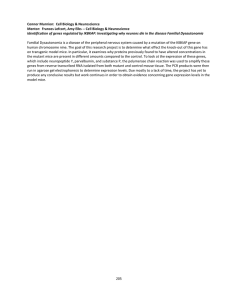Targeted gene mutation of the mviN locus Francisella tularensis Jeffrey Hall
advertisement

Targeted gene mutation of the mviN locus homolog in Francisella tularensis LVS Jeffrey Hall Mentor: Dr. Malcolm Lowry Department of Microbiology What is Francisella? • Gram (-) coccobacillus • Facultative intracellular pathogen • Zoonotic disease - Tularemia - Rabbit fever, Deer fever • Category A bioterrorism agent • can be easily disseminated or transmitted from person to person; • result in high mortality rates and have the potential for major public health impact; • might cause public panic and social disruption; and • require special action for public health preparedness. History of F. tularensis • Isolated by Edward Francis in 1911 in Tulare county, CA • Reported to be part of several countries biological warfare arsenal, including the United States • Aerosolization of F. t. by Russia; used against German advancement in WWII • Live Vaccine Strain (LVS) - attenuated strain -In 1960’s the US used LVS as vaccine for those in military at highest risk of contracting Tularemia Transmission Francisella tularensis Method of Infection • Francisella infects mainly macrophages and replicates to high numbers intracellulary • Ability to infect with as few as 10 CFU • Francisella can also infect epithelial cells - mechanism of entry is unknown • Molecular basis for evasion of immune response is unknown • Three potential virulence genes have been identified: iglC- no homologues mglA- transcription factor pdpD- no homologues. Challenges of Francisella • Slow growth, requires supplements to survive (freeze dried hemoglobin, MuellerHilton Broth) • Most known vectors don’t replicate in Francisella Francisella Growing On Francisella on Chocolate Chocolate Agar Plateagar • Difficult to introduce foreign DNA > electroporation very low efficiency > conjugation- possible • Much of the genome is still undetermined Method to Identify Virulence Factors Targeted Gene Mutagenesis Purpose: To create a knock of the gene 0369c in the mviN loci via a double homologous recombination event Choosing A Knock-Out Target mviN operon gene 0369c An operon that is homologous to a known Coxiella virulence factor mviN Operon Making Knock-Out Mutant 1st Step: Using 4 custom primers and PCR, create 2 fragments of the gene that omit the middle part of the gene Result: Lane 1: Gene Ruler 1kb Lane 2: Gene 0369c Fragment 1-2 (1400bp) Lane 3: Empty Lane 4: Gene 0369c Fragment 3-4 (1600bp) gene 0369c SalI 1 ATG AvrII 3 Flanking 1300 bp Flanking 1500 bp AvrII 2 Fragment 1-2 Stop SalI 4 Fragment 3-4 1500bp Making Knock-Out Mutant 2nd Step: Clone the Fragments independently into Topo TA pCR 2.1 cloning vector. SalI 1600bp Fragment 3-4 in Topo TA pCR 2.1 AvrII AvrII 1400bp Fragment 1-2 in Topo TA pCR 2.1 SalI Making Knock-Out Mutant 3rd Step A: Using a unique restriction site in the vector, RsrII along with the AvrII restriction site, the plasmids are digested and assayed on a 1% agarose gel. AvrII SalI SalI AvrII Fragment 3-4 in pCR 2.1 Fragment 1-2 in pCR 2.1 ~3 kb 4 kb 3 kb RsrII RsrII ~ 4kb Step B: Once separated, they are excised from the gel and purified out of agarose. Making Knock-Out Mutant 4th Step: The separate pieces are then ligated together to re-create a 7 kb vector AvrII SalI SalI 3 kb truncated gene 0369c RsrII SalI Flanking 1500 bp ATG AvrII ∆ AvrII Stop Truncated gene 0369c Flanking 1300 bp SalI Making Knock-Out Mutant 5th Step A: Once the fragments are ligated together, the vector is restricted with SalI to remove the 3 kb piece, gel separated, cut and purified out of the agarose gel, and then ligated with the pPV vector, which is also has restricted with SalI Sal I Sal I Sal I Δ0369c 3 kb fragment Sal I Sal I + pPV pPV suicide cloning vector Step B: Transform into DAP- E. coli = pPV-Δ0369c Making Knock-Out Mutant Conjugate E. coli with Francisella LVS (Transfer of plasmid) Harvest and plate on chloramphenicol & Polymyxin B (Selection for Francisella with integrated plasmid, i.e., single cross-over via homologous recombination) Wild-type 0369c ATG Stop replication ATG Stop Δ SalI SalI pPV-Δ0360c vector ATG Stop ~200 bp ~2000 bp Truncated 0369c pPV vector ATG 1061 bp Wild-type 0369c Stop Making Knock-Out Mutant Grow without selection (Allows for 2nd homologous recombination) Plate on 10% sucrose (Selects for loss of plasmid, carrying sacB) ATG Stop ~200 bp ~2000 bp Truncated 0369c pPV vector ATG 1061 bp Stop Wild-type 0369c •This 2nd recombination event will result in the Δ0369c being left in the chromosome and the vector and wild-type gene being removed ATG Stop ~200 bp ~2000 bp Truncated 0369c pPV vector ATG 1061 bp Stop Wild-type 0369c •This 2nd recombination event will result in the Δ0369c and the pPV vector being removed and the wild-type gene being left behind Making Knock-Out Mutant Final Steps: Replicate plate onto Chloramphenicol plates and no-selection plates (Confirms efficiency of sucrose “counter-selection”) Check for deletion of gene by PCR (Ideally, 50% are WT and 50% are mutants) ATG Stop Wild-type Stop codon primer mutant Start codon primer Start codon primer ATG ~200 bp mutant gene Stop codon primer Stop ~ 1000 bp Wild-type gene 1000 bp *Representation of gel electrophoresis 200 bp Conclusion • The Δ0369c gene construct was created and maintained successfully in E. coli • Unsuccessful in transferring the truncated gene into the pPV mutagenesis plasmid • Electroporation of Topo-Δ0369c unsuccessful Long Term Goals • Create and screen for an 0369c mutant in Francisella tularensis LVS • Assess role of the F. tularensis gene 0369c and the mviN operon in its ability to evade and infect macrophage cells • Assay will compare mutant vs. LVS, looking at multiplicity of infection (MOI) and length of infection. • Infection rate will be analyzed using the Enzyme-Linked ImmunoSorbent Assay (ELISA) technique. Future Research • Focus on continued screening for mutant LVS colonies • Generate a greater understanding of Francisella’s virulence mechanisms • Possibility for design of a new vaccine against Tularemia Acknowledgements • Lowry Lab – Dr. Malcolm Lowry – Lindsay Flax – Edward Lew • Häse Lab – Dr. Claudia Häse – Markus Boin • Dr. Kevin Ahern – Program Director • Department of Microbiology • Howard Hughes Medical Institute



